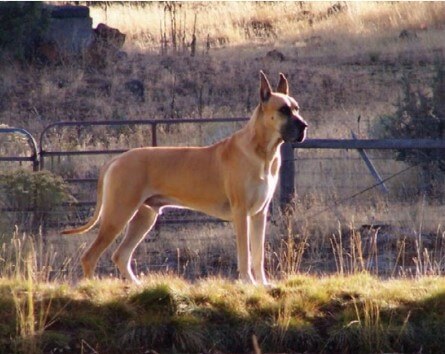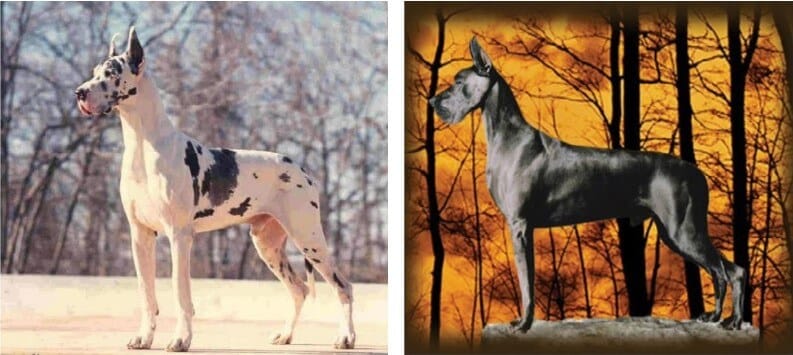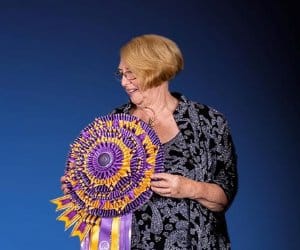Judging the Great Dane Breed
Being a non-coated breed, there is little need for a lot of hands on. You can see most of what you need to see—the balance, the angles, the topline, the croup—by just looking. Danes are a square breed and well-angled, so the first thing I look for is a balanced dog: height to length, bone to body, front angle to rear angle.
Ideally, you are looking for a smooth flow from the clean, tapered neck down into the withers, sloping smoothly into the short, hard back, continuing to the VERY slightly sloping croup. This is where the elegance of the Great Dane is created.

Height
A male should carry more bone and body than a bitch, though neither should be fine in bone or lacking in body.
Ideally, a Dane male will be 34 inches or more at the withers. Any male (even a puppy) is to be no less than 30 inches tall.
Ideally, a female will stand 31-32 inches tall at the withers, and must be a minimum of 28 inches.
These height requirements—30 inches for males and 28 inches for females—are disqualifications. All things being equal, the larger Dane is preferred, but not at the expense of overall soundness and balance.
I will take a handsome, 35 inch, short-backed, properly angled male any day of the week. Same for female—a 31 or 32 inch well-proportioned female is more than acceptable.

Type, style, movement, and balance…important words when judging Great Danes.
Head
The Dane head is rectangular, finely chiseled, clean, distinguished, and expressive. There should be a square jaw and broad muzzle. The planes should be parallel. Again, the masculinity of the male is seen in the head, as well as the femininity of the female head. The head should be in proportion to the body. The length of the muzzle and the length of the skull should be equal. A Dane should never be “cheeky”—we ask for flat planes.
The Dane head is a very large part of breed type. I am a great admirer of eye expression in this breed. The correct dark brown, tight, almond-shaped eye with its soft and gentle expression is something I treasure as a breeder of Fawns and Brindles. In Blues, a lighter eye is permissible as are blue eyes or eyes of different colors in Harlequins.
Cropping
The age old question… to crop or not to crop? It is one that breeders and owners have to ask themselves. Either is acceptable as long as the ear set is high and the ears are medium in size. Because Americans have not bred Danes for natural ears, they tend to be larger in size than English and Scandinavian Danes. However, we have breeders who are breeding for a smaller, more correct ear and most of the Danes with natural ears shown now have nice size ears.
Structure
Once boar and bear hunters, and guard dogs, we have made Great Danes into companion animals. They are, however, competing in the Working Group and need to be able to move as a unit, preferably with good reach and drive. Being put together properly helps them to move with less effort and proper stride. Again, when viewed from the side, the shoulder should have some angle and lay back, the topline should be straight, the hindquarter well muscled, the hock let down, and the pastern slightly sloping.
The forequarter of the Dane carries the body’s weight, and needs to be correct to obtain the proper gait and soundness we strive for. The dog must be balanced to move as a unit and without effort.
There should be no rolling of the topline and no twisting in or out at the hocks or elbows. Front fill, or forechest, usually comes with a properly laid back shoulder. It is an important part of the front assembly. Correct gait is an indication of proper structure.
Coat and Colors
Color often confuses people new to our breed. My suggestion is to judge them “naked.” Faults of color are not as serious as faults of structure and type. The coat itself should be short, thick, and clean!
We have six acceptable colors:
- Brindle
- Fawn
- Blue
- Black
- Mantle
- Harlequin (The Brindle, Mantle, and Harlequin are patterned.)
Any variance of color or pattern shall be faulted to the extent of the deviation. Any Dane that does not fall into the described color classifications is a disqualification. Notice we do not say patterns…just color. Therefore, a lightly-marked Harlequin or a heavily-marked Harlequin is not a DQ. A Mantle without a full collar is not a DQ, a Brindle without perfect chevrons is not a DQ. These are just a few examples of the deviations in patterns you will see. Colors will go from light to dark; again, deviations to be faulted to their extent. Our Standard clearly states what we consider ideal.
Temperament
Great temperament is paramount in this breed. The Standard says, “Spirited and courageous, never timid: always friendly and dependable.” The mere size of these dogs demands a dependable and friendly nature. We expect adult Danes to stand for examination.
A puppy may wag and take a step forward to greet a judge, this should not be penalized. Male puppies seem to be acutely aware of their “boy parts,” so when examining testicles on a puppy, please consider doing so from under the dog. I do this on all males.
We have seen the temperament in this breed changing. There seem to be many more timid Danes and some—hopefully not many—aggressive ones. Neither temperament is acceptable in this breed.
Type
To sum up, I’d like to quote the discussion in our Illustrated Standard.
“The essence of Great Dane type is created by the balanced combination of sculptured headpiece; long, tapered, clean neck; well developed body; strong bone; heavily padded feet; clothed in a glossy coat of correct rich color and moving with precision and grace. A substantial deficiency in any of these attributes will result in a lack of true Great Dane type—a ‘common looking’ dog. The presence or absence of breed type is the single most important factor in assessing the overall quality of the Great Dane.”
Type is defined as “typical of the breed”; in other words, how the breed should look, move and act.
Danes may be of different styles. A style is defined as how, within the parameters of the breed standard, we achieve a final appearance (one that pleases our different tastes). Style is a preference as long as you remain within the parameters of the Breed Standard.
Type, style, movement, and balance…important words when judging Great Danes.
Judging the Great Dane: Mighty Apollo of Dogs – Showsight Magazine October 2020 Issue
Great Dane Dog Breed Magazine
Showsight Magazine is the only publication to offer dedicated Digital Breed Magazines for ALL recognized AKC Breeds.
Read and learn more about the dependable Great Dane dog breed with articles and information in our Great Dane Dog Breed Magazine.
Error embedding FlippingBook shortcode, please check the flipbook url. (https://digital.showsightmagazine.com/view/137357/)











